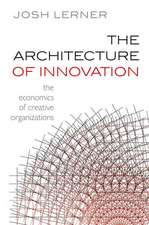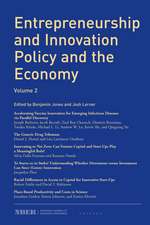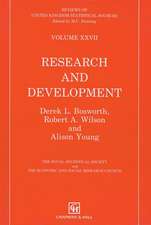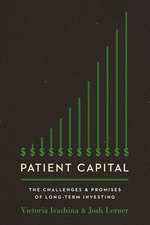The Rate and Direction of Inventive Activity Revisited: National Bureau of Economic Research Conference Report
Editat de Josh Lerner, Scott Sternen Limba Engleză Hardback – 15 apr 2012
While the importance of innovation to economic development is widely understood, the conditions conducive to it remain the focus of much attention. This volume offers new theoretical and empirical contributions to fundamental questions relating to the economics of innovation and technological change while revisiting the findings of a classic book. Central to the development of new technologies are institutional environments, and among the topics discussed here are the roles played by universities and other nonprofit research institutions and the ways in which the allocation of funds between the public and private sectors affects innovation. Other essays examine the practice of open research and how the diffusion of information technology influences the economics of knowledge accumulation. Analytically sophisticated and broad in scope, this book addresses a key topic at a time when economic growth is all the more topical.
Din seria National Bureau of Economic Research Conference Report
- 8%
 Preț: 536.74 lei
Preț: 536.74 lei - 5%
 Preț: 900.93 lei
Preț: 900.93 lei - 27%
 Preț: 751.40 lei
Preț: 751.40 lei - 9%
 Preț: 751.95 lei
Preț: 751.95 lei - 8%
 Preț: 535.63 lei
Preț: 535.63 lei - 9%
 Preț: 661.72 lei
Preț: 661.72 lei - 9%
 Preț: 777.88 lei
Preț: 777.88 lei - 9%
 Preț: 754.96 lei
Preț: 754.96 lei - 20%
 Preț: 737.44 lei
Preț: 737.44 lei -
 Preț: 350.11 lei
Preț: 350.11 lei - 27%
 Preț: 779.96 lei
Preț: 779.96 lei -
 Preț: 274.64 lei
Preț: 274.64 lei -
 Preț: 396.85 lei
Preț: 396.85 lei - 23%
 Preț: 672.49 lei
Preț: 672.49 lei - 23%
 Preț: 450.72 lei
Preț: 450.72 lei -
 Preț: 370.85 lei
Preț: 370.85 lei - 23%
 Preț: 597.89 lei
Preț: 597.89 lei - 23%
 Preț: 633.21 lei
Preț: 633.21 lei - 27%
 Preț: 715.19 lei
Preț: 715.19 lei - 23%
 Preț: 590.54 lei
Preț: 590.54 lei - 27%
 Preț: 717.44 lei
Preț: 717.44 lei - 27%
 Preț: 757.96 lei
Preț: 757.96 lei - 23%
 Preț: 623.75 lei
Preț: 623.75 lei - 23%
 Preț: 556.65 lei
Preț: 556.65 lei - 23%
 Preț: 616.34 lei
Preț: 616.34 lei - 27%
 Preț: 762.17 lei
Preț: 762.17 lei - 27%
 Preț: 802.94 lei
Preț: 802.94 lei - 27%
 Preț: 815.31 lei
Preț: 815.31 lei -
 Preț: 386.63 lei
Preț: 386.63 lei - 23%
 Preț: 454.87 lei
Preț: 454.87 lei - 27%
 Preț: 762.17 lei
Preț: 762.17 lei -
 Preț: 482.57 lei
Preț: 482.57 lei -
 Preț: 391.85 lei
Preț: 391.85 lei - 23%
 Preț: 629.08 lei
Preț: 629.08 lei - 20%
 Preț: 431.19 lei
Preț: 431.19 lei - 21%
 Preț: 366.61 lei
Preț: 366.61 lei - 22%
 Preț: 623.43 lei
Preț: 623.43 lei - 21%
 Preț: 423.62 lei
Preț: 423.62 lei - 15%
 Preț: 214.38 lei
Preț: 214.38 lei - 22%
 Preț: 613.74 lei
Preț: 613.74 lei - 20%
 Preț: 466.06 lei
Preț: 466.06 lei - 22%
 Preț: 551.50 lei
Preț: 551.50 lei - 16%
 Preț: 243.39 lei
Preț: 243.39 lei - 20%
 Preț: 494.56 lei
Preț: 494.56 lei - 21%
 Preț: 487.24 lei
Preț: 487.24 lei - 11%
 Preț: 301.72 lei
Preț: 301.72 lei - 21%
 Preț: 464.96 lei
Preț: 464.96 lei - 21%
 Preț: 378.38 lei
Preț: 378.38 lei
Preț: 872.19 lei
Preț vechi: 1194.78 lei
-27% Nou
Puncte Express: 1308
Preț estimativ în valută:
166.91€ • 173.20$ • 139.51£
166.91€ • 173.20$ • 139.51£
Carte tipărită la comandă
Livrare economică 15-29 martie
Preluare comenzi: 021 569.72.76
Specificații
ISBN-13: 9780226473031
ISBN-10: 0226473031
Pagini: 632
Ilustrații: 1 halftone, 49 line drawings, 54 tables
Dimensiuni: 152 x 229 x 46 mm
Greutate: 1.08 kg
Ediția:New.
Editura: University of Chicago Press
Colecția University of Chicago Press
Seria National Bureau of Economic Research Conference Report
ISBN-10: 0226473031
Pagini: 632
Ilustrații: 1 halftone, 49 line drawings, 54 tables
Dimensiuni: 152 x 229 x 46 mm
Greutate: 1.08 kg
Ediția:New.
Editura: University of Chicago Press
Colecția University of Chicago Press
Seria National Bureau of Economic Research Conference Report
Notă biografică
Josh Lerner is the Jacob H. Schiff Professor of Investment Banking at Harvard Business School, with a joint appointment in the Finance and the Entrepreneurial Management Units, and a research associate and codirector of the Productivity, Innovation, and Entrepreneurship Program at the NBER. Scott Stern is the School of Management Distinguished Professor of Technological Innovation, Entrepreneurship, and Strategic Management at the Massachusetts Institute of Technology Sloan School of Management and a research associate and director of the Innovation Policy Working Group at the NBER.
Cuprins
The Rate and Direction of Inventive Activity Revisited
Josh Lerner and Scott Stern, editors
Josh Lerner and Scott Stern, editors
Introduction
Josh Lerner and Scott Stern
I. Panel Discussion: The Impact of the 1962 Rate and Direction Volume, a Retrospective
Why was Rate and Direction So Important?
Nathan Rosenberg and Scott Stern
Some Features of Research by Economists on Technological Change Foreshadowed by The Rate and Direction of Inventive Activity
Richard R. Nelson
The Economics of Inventive Activity over Fifty Years
Kenneth J. Arrow
II. The University-Industry Interface
1. Funding Scientific Knowledge: Selection, Disclosure, and the Public-Private Portfolio
Joshua S. Gans and Fiona Murray
Comment: Suzanne Scotchmer
2. The Diffusion of Scientific Knowledge across Time and Space: Evidence from Professional Transitions for the Superstars of Medicine
Pierre Azoulay, Joshua S. Graff Zivin, and Bhaven N. Sampat
Comment: Adam B. Jaffe
3. The Effects of the Foreign Fulbright Program on Knowledge Creation in Science and Engineering
Shulamit Kahn and Megan MacGarvie
Comment: Paula E. Stephan
III. Market Structure and Innovation
4. Schumpeterian Competition and Diseconomies of Scope: Illustrations from the Histories of Microsoft and IBM
Timothy F. Bresnahan, Shane Greenstein, and Rebecca M. Henderson
Comment: Giovanni Dosi
Timothy F. Bresnahan, Shane Greenstein, and Rebecca M. Henderson
Comment: Giovanni Dosi
5. How Entrepreneurs Affect the Rate and Direction of Inventive Activity
Daniel F. Spulber
Comment: Luis Cabral
6. Diversity and Technological Progress
Daron Acemoglu
Comment: Samuel Kortum
7. Competition and Innovation: Did Arrow Hit the Bull’s Eye?
Carl Shapiro
Comment: Michael D. Whinston
IV. The Sources and Motivations of Innovators
8. Did Plant Patents Create the American Rose?
Petra Moser and Paul W. Rhode
Comment: Jeffrey Furman
9. The Rate and Direction of Invention in the British Industrial Revolution: Incentives and Institutions
Ralf R. Meisenzahl and Joel Mokyr
Comment: David C. Mowery
10. The Confederacy of Heterogeneous Software Organizations and Heterogeneous Developers: Field Experimental Evidence on Sorting and Worker Effort
Kevin J. Boudreau and Karim R. Lakhani
Comment: Iain M. Cockburn
V. Panel Discussion: Innovation Incentives, Institutions, and Economic Growth
The Innovation Fetish among the Economoi: Introduction to the Panel on Innovation Incentives, Institutions, and Economic Growth
Paul A. David
Innovation Process and Policy: What Do We Learn from New Growth Theory?
Philippe Aghion
VI. The Social Impact of Innovation
11. The Consequences of Financial Innovation: A Counterfactual Research Agenda
Josh Lerner and Peter Tufano
Comment: Antoinette Schoar
12. The Adversity/Hysteresis Effect: Depression-Era Productivity Growth in the US Railroad Sector
Alexander J. Field
Comment: William Kerr
13. Generality, Recombination, and Reuse
Timothy F. Bresnahan
Comment: Benjamin Jones
VII. Panel Discussion: The Art and Science of Innovation Policy
The Art and Science of Innovation Policy: Introduction
Bronwyn H. Hall
Putting Economic Ideas Back into Innovation Policy
R. Glenn Hubbard
Why Is It So Difficult to Translate Innovation Economics into Useful and Applicable Policy Prescriptions?
Dominique Foray
Can the Nelson-Arrow Paradigm Still Be the Beacon of Innovation Policy?
Manuel Trajtenberg
Contributors
Author Index
Subject Index


















